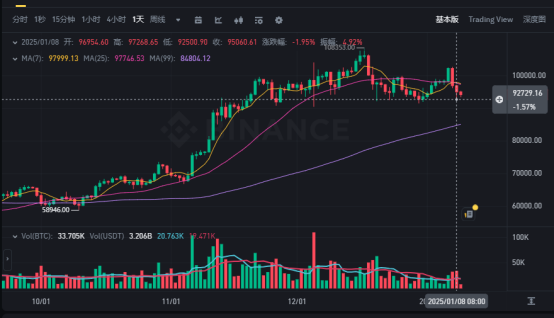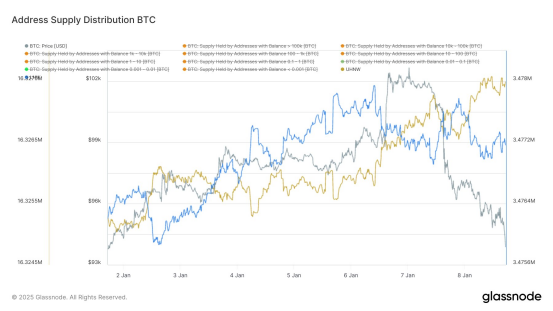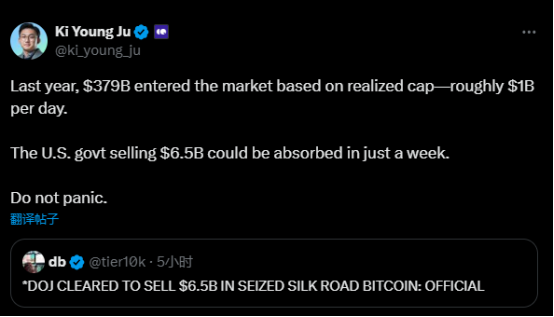As the clock strikes 2025, the market seems to have entered garbage time.
Even Bitcoin didn't expect that $100,000 would become the benchmark for bull and bear markets. It was thought that Bitcoin reaching $100,000 on Monday would mark the beginning of the next upward wave, but unexpectedly, after barely two days, Bitcoin began to lose momentum. During Tuesday's U.S. trading session, it hit a low of $92,600, dropping nearly 10% from Monday's high of over $102,000, and is currently reported at $94,212.

While Bitcoin watches from the sidelines, altcoins surrender. ETH has returned to $3,300, SOL has fallen below $200, and the altcoin sector has generally dropped by 10%, with institutional tokens like ADA, RNDR, and Aptos leading the decline. Even the U.S. stock market has been affected, with leading mining companies like TeraWulf, Bit Digital, Bitdeer, IREN, and Hut 8 seeing their stock prices drop by 5-8%.
Although the decline is still manageable, the fact that Bitcoin's low is already close to its price at the end of last year has caused market sentiment to ebb. The Silk Road sale has also doused the market with cold water, leading to various discussions, with several analysts even suggesting that Bitcoin could drop to $70,000 before Trump's inauguration speech. For instance, analyst Ali Martinez stated that the key support area for BTC is currently hovering between $97,041 and $93,806. He believes that if Bitcoin cannot meet this demand, it could significantly drop to $70,085.
To see if this prediction comes true, we first need to analyze the reasons for this round of decline.
The market generally believes that the macro data released on Tuesday was the trigger for this decline. The U.S. Bureau of Labor Statistics reported that the number of job openings in November exceeded 8 million, significantly surpassing expectations and reaching a six-month high. This JOLTS data was mainly driven by growth in the business services sector, while demand for workers in other industries was mixed.
In November, there were 8.098 million job openings in the U.S., compared to an expected 7.74 million, with the previous month's figure revised from 7.744 million to 7.8 million. The job openings in November continued the rebound trend from October. Just in September, JOLTS job openings had unexpectedly plummeted, hitting a three-year low, triggering recession fears.
Alongside the JOLTS data, the U.S. ISM Services PMI was also released. The ISM Services Index recorded 54.1 in December, above the market expectation of 53.3 and the previous 52.1. This growth was mainly due to a significant rise in the services prices paid sub-index, which jumped from 58.2 in November to 64.4, reaching its highest level since February 2023.
Overall, the macro data can be described as impressive, but such impressive data has led to a market decline. The market generally believes that due to the strong support from macro data, the Federal Reserve is very likely to maintain a hawkish stance, thus requiring a repricing of the interest rate cut path. In other words, with the macro environment improving, there is naturally no need to loosen monetary policy, but the liquidity shock to risk assets is difficult to avoid. After the data was released, traders no longer fully bet on the Fed cutting rates before July, leading to declines in the S&P 500 and Nasdaq, in contrast to the soaring U.S. 10-year Treasury yields and the dollar index.
Coincidentally, today the Federal Reserve released the minutes from the December FOMC policy meeting, which were largely consistent with last month, clearly stating that rate cuts will become more cautious. Committee members expect that the pace of rate cuts in 2025 will significantly slow down, with only a 75 basis point cut expected for the entire year.
The macro environment is a key backdrop, but Trump's bombastic rhetoric has further fueled capital's risk aversion sentiment.
Just yesterday, CNN reported that four sources revealed that U.S. President-elect Trump is considering declaring a "national economic emergency," which would provide a legal basis for imposing significant tariffs on allies and competitors. The report stated that once the U.S. enters a "national economic emergency," Trump would be allowed to utilize the International Emergency Economic Powers Act (IEEPA) to establish a new tariff plan, which unilaterally authorizes the U.S. president to manage imports during the relevant national emergency.
On January 7, during a 70-minute press conference at Mar-a-Lago in Florida, Trump made several outrageous statements, claiming that he would "use economic means" to make Canada the 51st state of the U.S., not ruling out the use of force to seize the Panama Canal and Greenland, and even promising to rename the Gulf of Mexico to "American Gulf." He also emphasized that if Hamas does not release Israeli hostages before he takes office, "the Middle East will descend into chaos." Such brazen rhetoric successfully drew criticism from countries like Canada and Denmark after the press conference, raising concerns in the market about the global economic outlook.
Due to the uncertainty surrounding macro rate cuts and tariffs, risk aversion sentiment has surged, leading to a decline in the three major U.S. stock indices, a sharp rise in the dollar index, and a plunge in non-U.S. currencies. The crypto market, of course, could not escape this trend. ETFs representing institutional funds also reflected this point, with a net outflow of $583 million from the U.S. Bitcoin spot ETF and a net outflow of $159 million from the Ethereum spot ETF on January 8, indicating a trend of capital outflow.
Another exacerbating event occurred this morning when DB News reported that, according to an official, the U.S. Department of Justice has been authorized to liquidate 69,370 BTC seized in the Silk Road case, with a total value of about $6.5 billion. The rumors are not unfounded; as early as December 3, the U.S. government transferred 19,800 Bitcoins related to Silk Road, worth nearly $2 billion, to Coinbase Prime, which the market interpreted as preparations for a government sale. The anticipated selling pressure has intensified market panic, causing BTC to briefly drop over 1%, once again falling below $94,000.
Despite the ongoing panic, from the current stage, there are less than 10 days until Trump’s official inauguration and speech, and February is also the earnings season, so the market outlook is still relatively more positive than negative. Additionally, there are still supportive positive signals from the news front.

The trading main line and key nodes for 2025, image source: CICC
First, the lawsuit between Coinbase and the SEC has seen a turning point. The U.S. District Court for the Southern District of New York has approved Coinbase's motion for a non-final appeal, allowing it to appeal the SEC's charges to the Second Circuit Court, during which the case is temporarily paused. The reason is that the judge believes there is a divergence in the legality of cryptocurrencies across different courts nationwide, thus requiring a ruling on this legality. If the Second Circuit agrees to hear the case, the federal government will have the opportunity to resolve the controlling legal issue regarding the SEC's statutory authority over digital assets. It is worth noting that since this is an appeal midway through the lawsuit, it significantly increases the likelihood of the case being dismissed, putting the SEC in a very passive position. If the appeal is successful, the SEC's issues regarding the securities nature of the coins listed on Coinbase may also be resolved, potentially advancing the altcoin ETF.
Second, the chairman of the CFTC, who once aimed to become the highest regulatory body for cryptocurrencies, has resigned, but in his last public speech, he still expressed positive sentiments regarding crypto regulation. Moreover, Trump's team has already begun to look for a successor who is friendly to cryptocurrencies. Current CFTC commissioner Summer Mersinger, a16z crypto policy director and former CFTC commissioner Brian Quintenz, and Kraken's chief legal officer Marco Santori are all under consideration. It can be seen that there is a high degree of consensus within Trump's team regarding the deregulation of crypto.
Against this backdrop, the attitude of whales towards Bitcoin's future trend is quite positive, with bargain hunting and bottom-fishing becoming common practices among them.
Data compiled by @Phyrex_Ni shows that panic sentiment is evident among small holders, with investors holding less than 10 BTC showing a clear trend of reduction in holdings during the recent two-day decline, while exchange holdings have also continued to decrease. In contrast, large holders are relatively confident, with investors holding more than 10 BTC showing a clear trend of increasing their positions.

Cauê Oliveira, head of research at Blocktrends, confirmed this data, stating that by the end of 2024, institutional investors had sold a large amount of Bitcoin, but are now starting to acquire it again at prices below $100,000. In the week following December 21, wallets holding 1,000 to 10,000 BTC sold 79,000 BTC, but recently, this group has begun accumulating when Bitcoin prices fell below $95,000.

As for the Silk Road, which has caused panic, its impact may not be as significant as expected. First, Trump has publicly promised that the U.S. government will not sell any Bitcoin after he is elected, which undoubtedly has a face-slapping tendency and may reverse later. Even if it is confirmed that sales can occur, from a timing perspective, it is not something that can be done overnight and may require several months of approval processes. Second, to maximize profits, large sales are usually conducted through over-the-counter acquisitions, which also makes the price impact relatively controllable. Furthermore, even if it is a one-time market entry, considering the current liquidity, it would only take a little over a week, which should not trigger panic. CryptoQuant CEO Ki Young Ju stated, "Based on realized market value, $379 billion entered the market last year, with about $1 billion in liquidity daily. The $6.5 billion (Bitcoin) sold by the U.S. government could be absorbed within a week."

Therefore, some institutions are very optimistic, believing that the decline caused by selling pressure is a buying opportunity. BitMEX co-founder Arthur Hayes commented on the Silk Road entering the market, stating, "Diamond hands are ready to bottom-fish."
Overall, although sentiment has receded and there is indeed panic, with the backing of institutional and whale bottom-fishing, even if the crypto market declines, it is unlikely to experience a collapse. The current Bitcoin bottoming concentration area remains around $95,000, with prices fluctuating around this benchmark. A significant drop may return to below $90,000, but the probability of reaching $70,000 to $80,000 is relatively low.
In addition to the ongoing attention to Trump's administration, the next important event for the market to observe is the U.S. non-farm payroll report for December, which will be released this Friday evening. Although Wednesday's ADP "small non-farm" data was below expectations, providing the market with a slight sigh of relief, the large non-farm data often shows significant discrepancies with ADP, and non-farm data is one of the key factors in the Fed's policy decisions, making it a focal point for the market. A weaker-than-expected job market could lead the Fed to pivot back to a dovish stance.
Currently, the market generally expects that the U.S. non-farm payrolls for December will slow to an increase of 153,000 jobs, with the unemployment rate remaining at 4.2%.
免责声明:本文章仅代表作者个人观点,不代表本平台的立场和观点。本文章仅供信息分享,不构成对任何人的任何投资建议。用户与作者之间的任何争议,与本平台无关。如网页中刊载的文章或图片涉及侵权,请提供相关的权利证明和身份证明发送邮件到support@aicoin.com,本平台相关工作人员将会进行核查。




